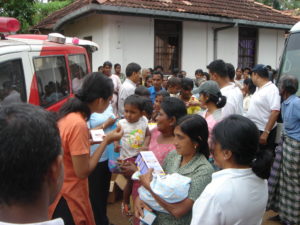Doctors in Sri Lanka: Grievances and Strikes
 Members of the doctors’ union Government Medical Officers Association (GMOA) undertook strikes in the Matara, Kandy, and Kurunagala districts of Sri Lanka on September 15. The strikes served to highlight the challenges that doctors, when returning to the country after pursuing an overseas education, face in securing admission for their children at government schools. The GMOA-led protests followed the convergence of doctors on the Ministry of Education the previous day. The Kaduwela Magistrate later demanded that the doctors cease their occupation of the Ministry.
Members of the doctors’ union Government Medical Officers Association (GMOA) undertook strikes in the Matara, Kandy, and Kurunagala districts of Sri Lanka on September 15. The strikes served to highlight the challenges that doctors, when returning to the country after pursuing an overseas education, face in securing admission for their children at government schools. The GMOA-led protests followed the convergence of doctors on the Ministry of Education the previous day. The Kaduwela Magistrate later demanded that the doctors cease their occupation of the Ministry.
The GMOA’s recent actions represent the latest in a series of strikes that doctors have mounted in response to a variety of developments affecting healthcare provisions and the status of healthcare providers over the past year. The Finance Ministry’s decision to revoke the right of government officials, including doctors, to import tax-free cars prompted a widespread strike that incorporated nineteen government institution trade unions. These included the GMOA, the Sri Lanka Executive Services Association, and the Sri Lanka Policy Planning Services Association, among others. Apart from demanding the reinstatement of vehicle rights, doctors who participated in the December 3 strike also sought a reduction in the flow of Indian employees into Sri Lanka and a restoration of government employee pensions.
Other protests have emphasized grievances specific to the medical community. A May 31 strike that spanned the majority of the districts sought to target what GMOA members perceived to be meddling on the part of the Ministry of Health in the transfer and selection of doctors. The GMOA accused two Health Ministry representatives of neglecting to involve doctors in the compilation of the post-intern vacancy roster. In the eyes of the GMOA, such an oversight failed to address the politicization of the appointment of doctors to posts in specific regions of the country. On July 4, GMOA members staged a strike that encompassed the entire island and garnered the support of the Government Dental Surgeons’ Association and the Ayurvedic Medical Officers’ Association. The strike targeted six different issues, including that of school admission for doctors’ children. The most prominent issue, however, revolved around private medical education. Citing concerns about educational transparency and quality, the striking doctors protested the granting of permission to graduates of the South Asian Institute of Technology and Medicine (SAITM), the country’s only private medical college, to receive the approval of the Sri Lanka Medical Council.
The potential of doctors’ strikes to negatively impact healthcare provision has already begun to manifest. Doctors continued to operate institutions and services related to essential relief and emergency care during the December 3 strike and the two following it. Nevertheless, the experiences of Colombo National Hospital patients during the December 3 strike demonstrate the ways in which service delivery was disrupted: two-thirds of incoming patients were turned away from the hospital and were unable to access the clinic, prescription medicine counter, and other facilities. The strikes’ adverse effects, coupled with a nationwide shortage of medical personnel, may provide an explanation for the willingness of the Sri Lankan government to engage in dialogue with and address the grievances of doctors and GMOA representatives in the aftermath of large-scale strikes.
